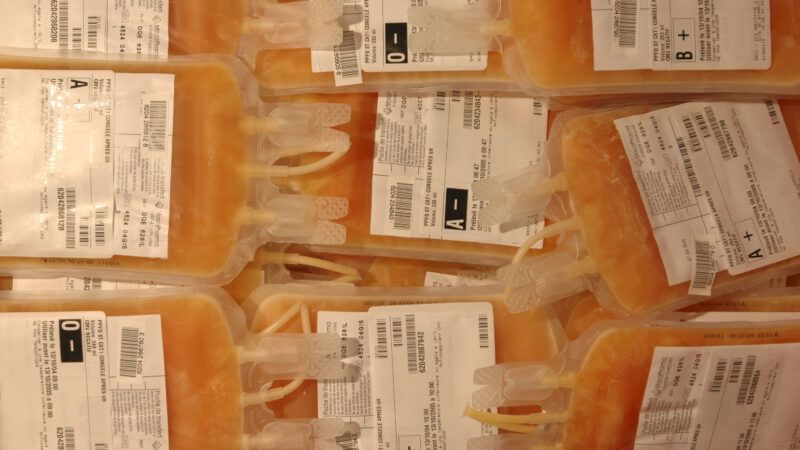The U.S. Is Trying To Keep Out Mexicans Who Want To Sell Their Blood Plasma
Paid plasma donation is a financial lifeline for Mexican donors and a medical lifeline for plasma-dependent patients.

Among other supply chain issues sparked by the COVID-19 pandemic, the world now faces a shortage of blood plasma, which is used in life-saving therapies for people who have certain chronic illnesses. A new policy implemented by the Biden administration serves to make that shortage worse.
On June 15, Customs and Border Protection announced that Mexicans would no longer be permitted to enter the U.S. on temporary visitor visas to sell their plasma. The new policy now designates Mexican donors "labor for hire," which makes it illegal for them to sell plasma while holding a B1/B2 visitor visa, as the majority of those donors have previously done.
The Immune Deficiency Foundation estimates that the restrictions on Mexican donors could reduce the U.S. plasma supply by 5–10 percent. Though that may not sound drastic, Georgetown University ethics professor and paid plasma expert Peter Jaworski calls it an "enormous" issue. Jaworski tells Reason that the pandemic had already reduced U.S.-based plasma collection by 20–25 percent. "We are in a medicinal crunch," he says. "We don't have enough of these medicines. Already there's a shortage in Spain…and in other parts of the European Union as well. Unless we figure out a way to increase plasma collection, we're not going to overcome those shortages."
Demand for plasma is rising, too—growing annually between 6–8 percent.* Plasma-for-pay is key to solving this issue, but few nations are willing to acknowledge that reality.
Just five countries allow donors to receive payment for blood plasma—the United States, Germany, Hungary, Austria, and the Czech Republic. That compensation model has led to these five nations having plasma collection surpluses, while countries that have to import plasma constantly grapple with shortages. Countries that allow paid plasma comprise 89 percent of the world's plasma supply. The U.S. provides over 70 percent, making Biden's move a potential catastrophe for the global importers of American plasma. In Spain, for example, La Razon reported that therapy providers have already had to space out plasma treatments due to shortages.
There are no alternatives to plasma-based medicines for the patients who use them. According to Jaworski, "they either get immunoglobulin or they suffer and sometimes die." Roughly 300,000 Europeans and 125,000 Americans rely on plasma therapies to treat chronic illnesses—like Von Willebrand disease and hemophilia—and many more are treated with plasma after traumatic accidents or in preparation for surgeries. Researchers have looked to plasma in their efforts to treat COVID-19 and Alzheimer's disease, making a reliable global supply all the more important.
Still, critics of paid blood plasma say the practice is exploitative. (A June ProPublica article celebrated Biden's June policy change with the headline, "The U.S. Is Closing a Loophole That Lured Mexicans Over the Border to Donate Blood Plasma for Cash.") They claim that plasma centers put Mexican donors at medical risk with the promise of making a quick buck. Beyond the blatant disregard for donor agency, that argument neglects how financially important paid plasma donation can be for people south of the border.
The U.S. caps donations at 104 per year, and with donors paid up to $40 for every donation, a Mexican donor could feasibly make over $4,000 annually from selling plasma. "The average salary in at least some of these border cities in Mexico is estimated to be about $9 a day," explains Jaworski. "Meanwhile, Mexicans could cross the border and get basically $80 a week donating plasma twice a week." Knowing that, Mexican donors have decided that selling plasma is a valuable opportunity to make some cash.
"Take anything that you think is exploitative. You need to look at what the second-best option for that group of people is," says Jaworski. "In banning the ability of Mexicans to cross the border to sell their plasma, we don't thereby put money in their pockets. So whatever it is that made them exploitable in the first place still exists."
"A lot of us were already unemployed and trying to make ends meet," Geraldo Rivera, a regular plasma donor from Mexico, told Texas Public Radio shortly after the policy change. "Now they say we can't donate and we don't know how we're going to survive."
"Whether I have a steady job or not, I'm going to go back to donating," Saul Vazquez, another frequent donor, told the El Paso Times.
Charges of high medical risk may well be overblown, too. The ProPublica article cautions that "frequent donors were underweight and showed low levels of antibodies," but Jaworski says this is "basically speculation." Paid plasma centers test potential donors' protein and hemoglobin levels to ensure collection will go smoothly.
Far from being an exploitative practice, paid blood plasma donation is a lifeline for many Mexicans, and absolutely essential for patients with autoimmune disorders and other immunodeficiencies who rely on these therapies. And yet, the Biden administration has decided to jeopardize the world's plasma supply, patient well-being, and the financial livelihoods of Mexican donors all at once.
*Correction: A previous version of this article referred to plasma demand tripling during the pandemic. That tripling is mostly due to rising demand for unpaid transfusable plasma, not the paid plasma used in therapies covered by this piece.


Show Comments (61)